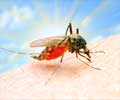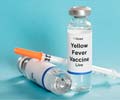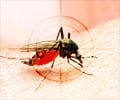Dengue, also known as 'break bone fever' is caused by the dengue virus. It sets in eight days after the mosquito bite. Mortality rate can be reduced to 15%, if timely treatment is provided.
The 'buzz' words today throughout the country are 'Dengue' and 'Chikungunya'. Both these flu-like illnesses, brought on by the bite of an infected Aedes aegypti female mosquito, have set the death bells knolling in several Indian states. Dengue is the most common mosquito-borne viral disease in the world according to WHO.
The administrative machinery is battling with a situation that is threatening to go out of hand unless a formidable solution appears on the horizon.The onset of monsoons in the country has led to a surge of breeding among these mosquitoes, which co exists with humans and share the same milieu. Both Dengue and Chikungunya are common to the tropics and are not contagious.
Aedes aegypti mosquitoes, which are the causative vectors of both Dengue fever and Chikungunya, carry the virus that causes these diseases. Please note the following about the Aedes mosquito –
· It is the female mosquito that feeds on blood as it requires the blood protein to produce its eggs.
· The female Aedes mosquito searches for suitable places to lay their eggs and it is usually the stagnant water.
· The male mosquitoes usually feed only on plant nectar.
· Aedes mosquitoes causing dengue usually bite during the day, unlike those that cause malaria, and their biting spree lasts from dawn to dusk.
· The mosquito is attracted by the body odours, carbon dioxide and heat emitted from the animal or humans.
Dengue, also known as 'break bone fever' is caused by the dengue virus. It sets in eight days after the mosquito bite. Mortality rate can be reduced to 15%, if timely treatment is provided. Dengue fever is sub- typed as Classical and Hemorrhagic.
In the Classical type of fever the patients suffer from all the typical symptoms, but the mortality rate is very low. The Hemorrhagic fever or 'Shock Syndrome' is the severe variety, which could be fatal. The patient suffers from high fever, bleeds from the nose, ears, gums and the skin and enters a state of shock due to blood loss. Most often death becomes inevitable and occurs within 24 hours, especially among children. This type of fever is fatal in 5% of those affected.
Chikungunya fever is another highly disabling disease, which has of late taken epidemic proportions. The word 'Chikungunya' which originated from the Swahili word meaning 'that which bends' refers to the stooped, arthritic posture acquired by the affected individual. The Chikungunya virus, also known as the 'buggy creek virus' is transmitted again by the Aedes aegypti mosquito. Symptoms develop within a day or two of biting.
Diagnosis of both Dengue and Chikungunya is possible by carrying out serological tests, using blood samples, which will show the presence of antibodies for the concerned virus, indicating infection.
Managing the disease by treating its symptoms is the only method for both Dengue and Chikungunya. Fever and joint pain may be controlled by the paracetamol group of drugs. Severe cases of Dengue or Chikungunya may require IV fluid infusion. In case of severe bleeding, as in Dengue, blood transfusion may be required. Adequate rest and supportive care is an absolute requirement.
Although no vaccinations are currently available for use, clinical trials have been initiated for a vaccination against Dengue fever. The following are some of the steps that should be taken to prevent these fevers from snowballing into an epidemic:
· Avoid stagnant water around houses to get rid of mosquito breeding sites. Clear water from:
o Flower pots
o Buckets
o Barrels.
o Tyres - especially if used for swings
· Store water under cover
· Use mosquito nets during nights
· Use mosquito repellant creams or coils containing DEET to avoid mosquito bites
· Use bleaching powder mixed in water if it is not tube used for drinking.
· Measures should be taken to prevent mosquito breeding in stored water bodies, like wells
· Destroy discarded objects like old tyres, coconut shells and bottles, as they collect and store rain water
· Wear bright and light color clothing, as mosquitoes are attracted to dark clothing.
· Wear long sleeved clothes and long pants.
· Wear boots and socks and if necessary tuck the pants into the socks
· Avoid outdoor activities during dawn or dusk when these mosquitoes are most active
· Avoid strong perfumes as they attract mosquitoes
Most patients diagnosed with Dengue and Chikungunya recover completely within a span of few weeks. Joint pain may persist for a period of time in patients with Chikungunya. In some cases, physiotherapy may be resorted to restore normalcy. It is common for the patient to feel incapacitated and depressed after the fever. Deaths may occur due to the inappropriate use of drugs or non-availability of treatment on time. Redressal of the issue on an emergency scale, creating awareness among the masses, implementation of appropriate measures and timely medical care will put the afflicted back on the road of recovery.
Source-Medindia











